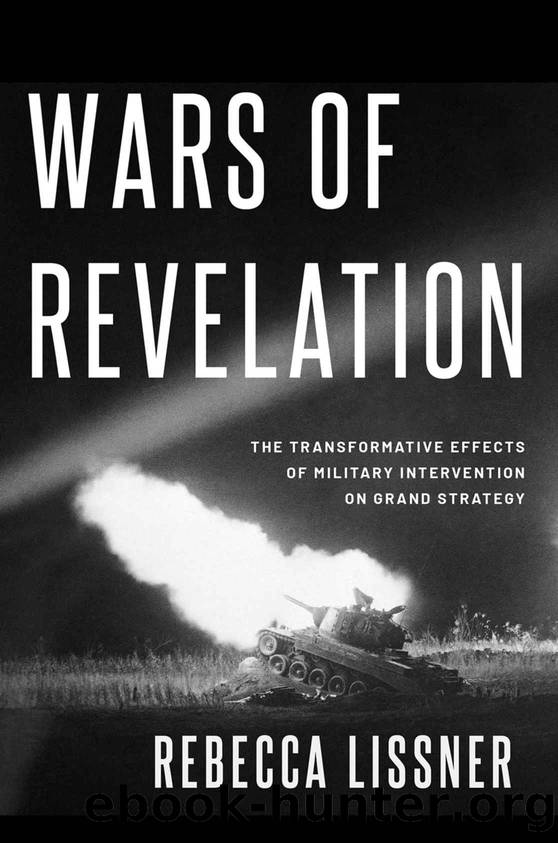Wars of Revelation by Rebecca Lissner

Author:Rebecca Lissner [Lissner, Rebecca]
Language: eng
Format: epub
Publisher: Oxford University Press
Published: 2021-10-11T16:00:00+00:00
Prewar Assessment of U.S. National Power
Prior to the Gulf War, the Bush administration struggled to define the purpose of American power in a world that had moved beyond Cold War rivalries. In March 1989, Scowcroft wrote to the president, âYou will, in due course, need to lay out a vision of American power. . . . We need to establish the principle that American power is not simply a reaction to Soviet military capability.â47 The administration was anxious to avoid the mistake of postâWorld War II, as well as post-Vietnam, demobilization, not to mention postâWorld War I isolationism.48 The Europeanists on the NSC staff came up with the tagline âcommonwealth of free nations,â which appeared in a few presidential speeches.49 Others in the White House had thrown around the idea of âsustainment,â but the Pentagon objectedâperhaps âassuranceâ or âpreserving a framework for peaceâ would be better, senior defense official Scooter Libby suggested. Acknowledging the inadequacy of these suggestions, he conceded: âReplacing âcontainmentâ is in the end a very difficult task.â50 The terminological muddle gestures at a deeper conceptual confusion that plagued the Bush administration during this period. After decades of seeking the downfall of the Evil Empire, it was not clear for what else U.S. power could or should be used.
Moreover, in 1989 and 1990, it appeared that the United States would operate within a system that was at least somewhat multipolar. Moscow was clearly diminishing, but American allies seemed on the ascendance, placing a premium on cooperative diplomacy and economic exchange. Europe was a ârising economic superpower,â51 a reunified Germany would only grow in economic and political heft, Japan seemed to be re-emerging as a great power, and âAsian Tigerâ economies were rising.52 It appeared the global balance of power was âshifting . . . among industrial democracies.â53 The Bush administration proclaimed that âthe rise of other centers of power in the free world is . . . welcomeâ and called on allies and friends to assume a greater share of global leadership.
Stability and balance were paramount in such a world.54 The 1990 NSS prescribed a grand strategy intended to âpreserve the international equilibrium.â55 President Bush, when asked to identify NATOâs greatest post-Soviet adversary, responded: âThe enemy is unpredictability. The enemy is instability.â56 Even at a regional level, strategic ends rested on the maintenance of âstable regional military balances.â57 Former national security advisor Zbigniew Brzezinski identified the contours of this nascent grand strategic outlook in a June 1989 Washington Post piece: â[The Bush Administration is pursuing a] grand strategy that would shape a more cooperative world order in which America remains the essential balancer and key source of stability.â58 Washington could not yet imagine a unipolar international system that derived its stability from the very absence of a power balance.59 Instead, the future order envisioned by this grand strategy was a multipolar one, at least economically and diplomatically.60
This vision of multipolarity rested on the notion that it was economic and diplomatic power, rather than military power, that would matter most in this emerging global order.
Download
This site does not store any files on its server. We only index and link to content provided by other sites. Please contact the content providers to delete copyright contents if any and email us, we'll remove relevant links or contents immediately.
The Secret History by Donna Tartt(16662)
The Social Justice Warrior Handbook by Lisa De Pasquale(11494)
Thirteen Reasons Why by Jay Asher(7803)
This Is How You Lose Her by Junot Diaz(5800)
Weapons of Math Destruction by Cathy O'Neil(5046)
Zero to One by Peter Thiel(4835)
The Myth of the Strong Leader by Archie Brown(4796)
Promise Me, Dad by Joe Biden(4456)
Beartown by Fredrik Backman(4434)
Stone's Rules by Roger Stone(4423)
How Democracies Die by Steven Levitsky & Daniel Ziblatt(4414)
The Fire Next Time by James Baldwin(4351)
100 Deadly Skills by Clint Emerson(4086)
A Higher Loyalty: Truth, Lies, and Leadership by James Comey(4041)
Rise and Kill First by Ronen Bergman(4021)
The David Icke Guide to the Global Conspiracy (and how to end it) by David Icke(3891)
The Farm by Tom Rob Smith(3878)
Secrecy World by Jake Bernstein(3789)
The Doomsday Machine by Daniel Ellsberg(3737)
